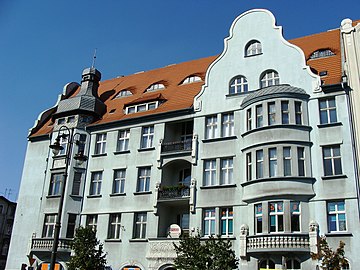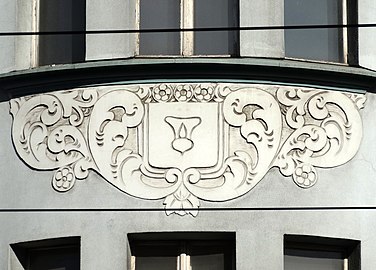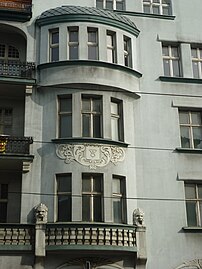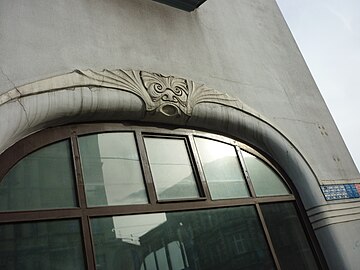Rudolf Kern Building
| Rudolf Kern Tenement | |
|---|---|
Polish: Kamienica Rudolfa Kerna w Bydgoszczy | |
 Tenement from Gdańska Street | |
 | |
| General information | |
| Type | Tenement |
| Architectural style | Art Nouveau |
| Classification | Nr.601377-Reg.A/1086, 20 November 1995[1] |
| Location | 1 Mickiewicz Alley, at the intersection with Gdańska Street, Bydgoszcz, |
| Coordinates | 53°7′55″N 18°0′36″E / 53.13194°N 18.01000°E |
| Groundbreaking | 1903 |
| Completed | 1904 |
| Client | Rudolf Kern |
| Technical details | |
| Floor count | 5 |
| Design and construction | |
| Architect(s) | Rudolf Kern |
Rudolf Kern Tenement is a habitation building located at 1 Mickiewicz Alley, in Bydgoszcz, Poland. It has been inscribed on the Kuyavian-Pomeranian Voivodeship Heritage List.
Location[edit]
The building stands on the eastern side of Gdańska Street at the intersection with Mickiewicz Alley.
It stands close to remarkable tenements in the same street:
- Alfred Schleusener Tenement at 62;
- Józef Święcicki tenement at 63;
- Eduard Schulz Tenement at 66/68;
- Tenement at 71 Gdańska street;
- Tenement at 75 Gdańska street;
- Ernst Bartsch tenement at 79;
- Paul Storz Tenement at 81.
History[edit]
On the plot, before the current building, there was a tavern (German: wirtschaft), managed by Emil Manthei[2]
This made the area prone to leisure, emphasized by the presence, since the end of the 19th century, of a theatre and a restaurant on the other side of the intersection (at 66-68 Gdańska street).
The house was built in 1903–1904, designed by the architect Rudolf Kern, a student of Józef Święcicki who also erected or redesigned other buildings in Gdańska Street:[3]
- August Mentzel Tenement at 5;
- Eduard Schulz Tenement at 66/68;
- Tenement at 71 Gdańska street.
Rudolf Kern originally erected the tenement for his own use, private and business. He lived there until 1922.
The building will soon accommodate a four-star hotel, including a gastronomic restaurant, with recreational and commercial areas.[4]
Features[edit]
The building has a decorative Art Nouveau facade. It has four main floors and one hidden in the upper roof. In a way its size balances the symmetry with the opposite building.[5]
It is characterized by an asymmetric arrangement of loggia and bays, typical decorative elements including leaf and tendril motifs, intertwined organic forms, mostly curvaceous in shape.[5]
Notable elements:
- low-relief adorned portal;
- large threatening masks on the facade;
- many interior design original elements such as staircase, stained glass, woodwork.
The building has been put on the Kuyavian-Pomeranian Heritage List Nr.601377 Reg.A/1086, on 20 November 1995.[1]
Gallery[edit]
-
Frontage onto Mickiewicz alley
-
Art Nouveau detail
-
Masked faces on the facade
-
Detail of the portal
-
Detail of the carved door
-
Detail of a bow window
-
Detail of a motif
See also[edit]
References[edit]
- ^ a b zabytek|kujawsko-pomorskie|issued=1.03.2014
- ^ "names". Adressbuch nebst allgemeinem Geschäfts-Anzeiger von Bromberg und dessen Vororten für 1900: auf Grund amtlicher und privater Unterlagen. Bromberg: Dittmann. 1900. p. 126.
- ^ Jastrzębska-Puzowska, Iwona (2006). Od miasteczka do metropolii. Rozwój architektoniczny i urbanistyczny Bydgoszczy w latach 1850–1920. Bydgoszcz: Mado. ISBN 8389886715.
- ^ Tota, Justina (23 February 2017). "W kamienicy na rogu Gdańskiej i Mickiewicza będzie hotel". expressbydgoski.pl. expressbydgoski. Retrieved 21 May 2018.
- ^ a b "Art Nouveau Design: Characteristics, History, Artists". visual-arts-cork.com. Retrieved 6 March 2015.
External links[edit]
Bibliography[edit]
- (in Polish) Bręczewska-Kulesza Daria, Derkowska-Kostkowska Bogna, Wysocka A. (2003). Ulica Gdańska. Przewodnik historyczny. Bydgoszcz: Wojewódzki Ośrodek Kultury w Bydgoszczy. ISBN 9788386970100.









